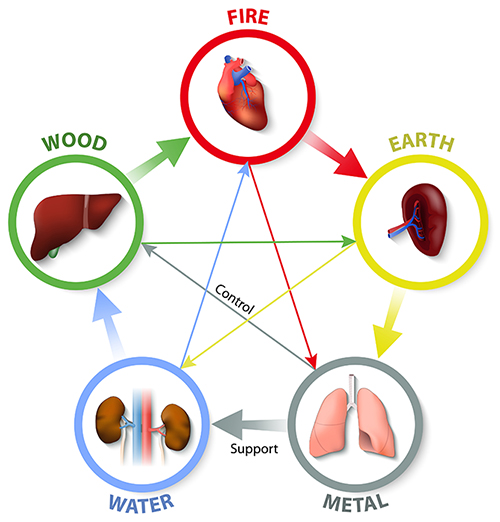Five Elements Theory
The Five Elements theory posits wood, fire, earth, metal, and water as the five fundamental energies in nature. Each represents different properties and functions. It describes interactions and relationships between all natural phenomena. In TCM, five elements theory is applied to explain the mutual interactions of internal organs.
Five Element Associations
| Wood | Fire | Earth | Metal | Water | |
|---|---|---|---|---|---|
| Zang Organs | Liver | Heart | Spleen | Lung |
Kidney |
| Fu Organs | Gallbladder | Small intestine | Stomach | Large intestine | Urinary bladder |
| Sense | Eyes | Tongue | Mouth | Nose | Ears |
| Tissue | Sinews | Vessels | Muscles | Skin | Bones |
| Fluid | Tears | Sweat | Thick Saliva | Phlegm | Saliva |
| Taste | Sour | Bitter | Sweet | Pungent | Salty |
| Emotion | Anger | Joy | Worry | Grief | Fear |
| Sound | Shouting | Laughing | Singing | Crying | Groaning |
| Stage | Birth | Growth | Ripening | Harvest | Storage |
| Season | Spring | Summer | - | Fall | Winter |
| Climate | Wind | Heat | Dampness | Dryness | Cold |
| Direction | East | South | Center | West | North |
| Color | Green | Red | Yellow | White | Black |
Inter-Relationship of Five Elements
The Five Elements are dynamic: they create, control, and constantly interact with each other. Disturbances in the harmoniously coordination of elements can give rise to disease.
Generating
Each element generates another element, like the mother gives birth to and nurtures the child.
- Fire (Heart) generates Earth (Spleen).
- Earth (Spleen) generates Metal (Lung).
- Metal (Lung) generates Water (Kidney).
- Water (Kidney) generates Wood (Liver).
- Wood (Liver) generates Fire (Heart) .
Controlling
Each element controls and is controlled by another element, creating a system of checks and balances. Ideally, this system guarantees that one element will not over-dominate another element for any lengthy period.
- Fire (Heart) controls Metal (Lung).
- Metal (Lung) controls Wood (Liver).
- Wood (Liver) controls Earth (Spleen).
- Earth controls (Spleen) Water (Kidney).
- Water (Kidney) controls Fire (Heart).
